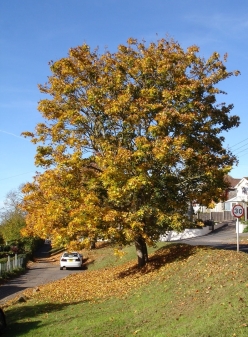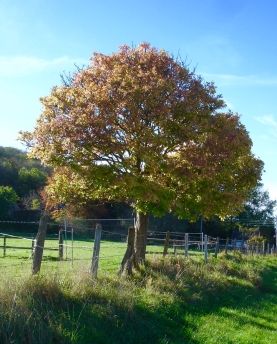Thoughts on …
Thanking a tree this autumn 3/11/16
We are presently surrounded by great glories of nature. They are glories which this year are especially magnificent. They can be seen everywhere, by everyone. There are millions of them, all unique, all wonders to behold. And behold them we must – in our towns and cities where they proclaim their splendour in parks, in gardens and even in the streets, and in the countryside where they proudly stand in fields, woods and hedgerows. Sometimes these glories of nature are solitary, sometimes they stand in rows, and often they live close to each other in small or large communities.

Constantly whispering and muttering they raise their voices when the wind blows and make the sound of the sea on the shingle. At the appointed time they put on new coats of copper and gold, not flaunting their garments but certainly inviting us to take notice.
These glories are our trees. Faithful and sturdy companions, beautiful and fascinating, they have the power to give us good feelings. We must acknowledge their presence, befriend them and not take them for granted as too often we do. They are glorious at other times of the year with their hues of green in spring and summer, and their striking silhouettes in winter. But they are even more glorious in autumn when the colour of their leaves transforms our vistas and on grey, mournful days lights up the rural or urban scene. It is in their dying, we should remember, that their leaves are alive with colour.
It is not only their leaves which are jewels of the natural world. Trees have other precious gifts to offer. In spring they share their buds and blossom, in autumn they give us fruits and berries, seeds and nuts. The glossy horse-chestnut inside a green, half-open shell must surely be among the most precious jewels they offer but they bestow many more treasures besides. There are the red berries of the hawthorn and rowan, and, if you are lucky enough to come across them at the right time, the exquisite, unusually shaped, pink and orange berries of the spindle. There are brightly coloured apples, of course, and there is the fruit of the blackthorn – dark blue sloes with a bloom on their skins. Adding to the bounty are acorns, beech nuts, hazel nuts, ash keys and the winged seeds of the sycamore. I hope children still throw sycamore seeds in the air and watch them spin to the ground looking like helicopters but I wonder nowadays how many do this.
All these gifts make trees an essential part of the web of life and great providers. Their presence supports and sustains the ecosystem of our countryside through the provision of food for a huge variety of creatures from birds to badgers to beetles. Collectively and individually they provide a habitat for a myriad of living thing, oak trees being particularly munificent in this respect.1
We are blessed to be surrounded by such majestic plants as trees. This year I have been transfixed by their glowing colours. I have also had the pleasure of walking beneath lines of magnificent beeches, admiring the leaves remaining on them and swishing through those that had fallen. And I am enjoying, as I always do, two special glories in my garden – an ornamental cherry with leaves like flames and a spindle with its pink berries which will soon burst open to reveal orange-coloured seeds.

This week we should make some time to look at trees in all their glory, absorb what we see and let this vision touch our soul. We should listen to them rustling in the breeze, watch their leaves twisting and tumbling to the ground, and, whatever our age, swish through them as we walk along paths and pavements.
As we gaze in wonder at what is before us maybe we can borrow a bit of Wordsworth to help us articulate the experience: Earth has not anything to show more fair/Dull would he be of soul who could pass by/A sight so touching in its majesty.2
Over the next week or so I think we should all find one tree in particular to befriend. We can hug it if we wish but we don’t have to. We can write a poem about it if we feel so moved, or we can paint a picture. We can, and should, take a photograph on our mobile phones and share it with other people. And when we have done this we can, and should, quietly say … thank you tree, thank you for making me feel good.
1 Two good links about the oak are: www.oldknobbley.com; www.kew.org/science-conservation/plants.../quercus-robur-english-oak
2 These lines do not describe trees or, indeed, anything in the natural world. They refer to the view of London looking from Westminster Bridge.
For some more autumn colour click here.
